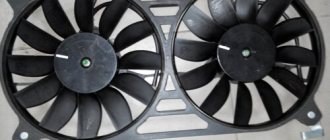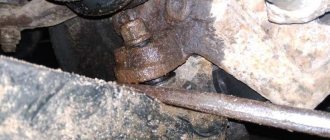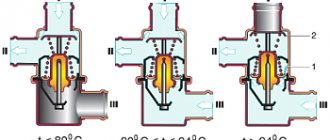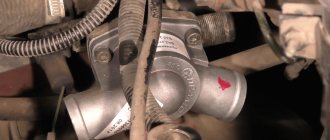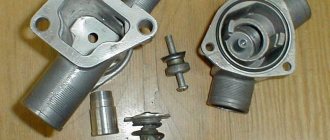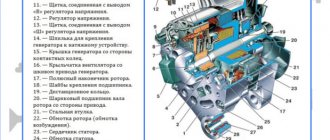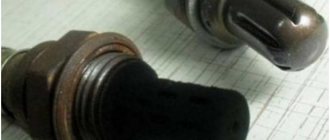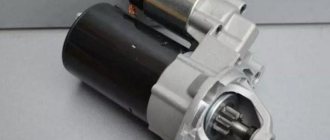Replacing the thermostat
Remove the air filter.
Drain the antifreeze into a prepared container.
Remove the four hoses by lowering the clamps. Keep in mind that a small amount of antifreeze may spill.
Carefully remove the thermostat.
We clean the nest from dust and other residues. We take a new thermostat and apply a layer of sealant to all joints with the hoses, then wait 10 minutes.
To further install the new thermostat, follow these instructions in reverse order:
- install four hoses;
- fill with coolant;
- install the air filter.
Removing the air filter housing
We unscrew the 2 nuts from the front and pull out the plug behind the body.
We remove the connector from the MAF sensor; you need to press the latch from below and pull the connector.
After loosening the clamp, carefully remove the air hose.
Slowly remove the air filter housing, slightly loosening it.
The filter is assembled in the same way, but in reverse order.
Features of testing on VAZ series cars
VAZ cars continue to be a truly “people's” vehicle. Let's look at how to check the thermostat on a car of this brand.
To begin with, we note that on all models of the Volzhsky Automobile Plant (VAZ 2107, 2114, 2109, 2110, 2114 and others), the principle of checking the thermostat is identical. The only thing that can change is the opening and closing temperature. But this information can be found in the instructions for your car.
As in previous cases, verification is carried out using two methods.
Purpose, design and principle of operation of the thermostat
The coolant circulating through the working channels of the engine blocks, its main purpose is to remove excess heat accumulated in the power unit due to the friction of the working elements of the engine and the impact of the high temperature of the exhaust gases passing through the exhaust circuit.
The main elements of the cooling system of the VAZ 2114, which are responsible for lowering the temperature of the antifreeze, are the electric cooling radiator fan and the thermostat.
To understand the principle of its operation, you need to see what the thermostat on a VAZ 2114 looks like. Structurally, it is designed in such a way that the valve that regulates the coolant flow is located inside a housing with three pipes:
- two inputs - from the engine and radiator;
- one day off - to the pump.
The main working element of the valve itself, located inside the thermostat, is a solid heat-sensitive filler, which, when heated, through a rubber insert, acts on the piston that moves the main valve. When it heats up, it opens it, when it cools down, on the contrary, it closes the hole, preventing the flow of antifreeze.
We recommend: Tread depth of winter and summer tires - permissible height
The thermostat is attached to the engine through a pipe to the cylinder head on the left side, under the air filter. It is connected to the radiator and pump using rubber pipes. On a cold engine, the valve of this coolant flow regulator is closed and after starting, the liquid that begins to be pumped by the pump forces moves along a “small circuit” or “in a small circle.” Both of these expressions are used among motorists. When moving in a small circle, the antifreeze passes through the heater radiator, intake manifold and throttle assembly. Liquid is not supplied to the radiator; the valve cuts off this path.
As the engine heats up, the coolant takes away some of the heat, heats up and, passing in a “small circle” through the thermostat, heats the temperature-sensitive element. The piston begins to move and open the main valve. This begins to happen when the liquid temperature reaches 87 degrees. In this case, part of the coolant begins to circulate through the radiator. When the temperature reaches 102 degrees, the valve opens completely, moving eight millimeters. In this mode, the entire coolant flow rushes in a “large circle” through the cooling radiator.
Experts recommend checking the operation of the thermostat without removing it from the car. To do this, after starting the engine, you need to touch the lower pipes coming from the radiator with your hands. They should be cold until the temperature rises above eighty degrees. As soon as the temperature rises above 85 degrees, the tubes should begin to heat up and after a while you can feel that the “large circle” circulation is working. The tubes should get quite hot.
If the lower pipes leaving the radiator continue to remain cold, it means the main valve has not opened and the thermostat is faulty. A malfunction of this regulator may also be indicated by the fact that the lower tubes begin to heat up almost immediately after starting the engine. This indicates that the valve is open and does not close when cold.
In both cases, a thermostat failure does not bring anything good for the engine. In the case when the valve is open, the antifreeze, passing in a “large circle,” does not have the opportunity to heat up to working condition. This reduces engine power and other performance parameters. In the case when the main valve is closed, the engine has a high risk of overheating the blocks. This is the most dangerous condition for the power unit. If you drive in this mode for some, even not very long, time, you can damage the engine, even to the point of breaking the shafts. And this, at a minimum, is a major overhaul of the entire internal combustion engine.
We recommend: How to clean carbon deposits on car spark plugs?
There is a different way to check the thermostat on a VAZ 2114. To do this, you need to pour water into a pan and, placing it on the stove to heat, immerse the thermostat there. Knowing at what temperature the thermostat on the VAZ 2114 opens, use a thermometer to monitor the heating of the water in the pan. At about 87 degrees the valve should open. If this happens, then the device is fully operational. It is better to check it in this way before installing it in place of a failed one.
Many car enthusiasts often ask specialists whether it is possible to repair the thermostat.
There is only one fairly reliable way to help the valve work. To do this, lightly hit the device body with a screwdriver several times. The impact should open the valve.
If this does not happen, then the thermostat on the VAZ 2114 needs to be replaced.
Types of VAZ thermostats and which one is better
Visually, even an experienced salesman cannot distinguish a kopek thermostat from a Niv one. Because the difference is inside them and in the location of the pipes. All Togliatti thermostats are made according to the ancient Fiat design - they are removed from the cylinder head into a separate unit and fixed to the pipes and hoses of the cooling system. Here are the main types of VAZ thermostats:
- All classic Zhigulis had a 2101 thermostat under the hood , which can be identified by the location of the pipes; they are turned opposite each other almost at a right angle.
However, the most important difference is that the thermal operating conditions of rear-wheel drive Zhiguli engines required blocking the valve at 80 degrees and fully opening it at an antifreeze temperature of 95 degrees. Thermostat VAZ-2101 - Exactly the same device was installed and is being installed on Niva .
The only difference is that the angle between the pipes tends to 180 degrees. Thermostat VAZ 21213, 21214 (Niva) - A figure-eight thermostat is installed on all carburetor Samaras in their countless modifications. The difference with classic motors in terms of thermoregulation is that in thermostat 2108 the valve should operate seven degrees later. This happened due to the more advanced design of the combustion chamber, so until the antifreeze temperature reaches 87 degrees, the valve should be closed, and only at 102 degrees should it open.
Thermostat VAZ-2108Modern thermostats on the spare parts market are not distinguished by high accuracy and high quality workmanship, so after a series of tests the plant gave two degrees to the manufacturers. As a result, on boxes with thermostats for the entire Samara family, you can often see the number 85. Visually, the 2108 thermostat is distinguished by the presence of a thin pipe to remove possible air bubbles.
- The tenth VAZ family received exactly the same thermostat housing as on the classic, but in a mirror image. It does not have a small pipe for air outlet, since the design for the carburetor tens provided a separate tee, which greatly complicated the decoupling of the hoses under the hood. By the way, the figure-eight device is also perfect for carburetor tens; the only thing you need to do is tightly plug the small air hole.
Thermostat VAZ-2110Such thermostats have become the most popular, so when purchasing them, you should definitely look inside; there should be a curtain made of plastic or metal, which better redistributes the flow of liquid to the thermoelement. If it is not there, the valve response temperature can differ greatly (up to 10-15 degrees) from the nominal value, which leads to overheating of the engine.
- The thermostat of the 2112 family is designed specifically for injection VAZ engines .
Actually, the thermostat doesn’t care what type of power system it is, it does its job and if the manufacturer is conscientious, the valve will always be closed up to a temperature of 85 degrees. Thermostat VAZ-2112
"Injection" thermostats
The trick of injection thermostats is that they significantly improve the performance of the heating system. To do this, it was necessary to increase the intensity of the passage of liquid through the cold circle precisely due to the thermostat - a special throttle was installed in the inlet pipe, and in the latest versions there will be as many as four holes.
That is why in everyday life such thermostats are called “6-hole.” For this reason, such thermostats are optimal for all injection VAZ cars, including the VAZ-2114. This is exactly what they replace from Granta.
Checking a new thermostat before installation
Before replacing the VAZ-2114 thermostat, you need to check the functionality of the new one. The check is performed in the following order:
- Fill the container with water and place the device in it.
- Place the dish with the appliance on the stove and heat it, controlling the heating temperature.
We heat the water with the device, controlling the temperature
- When the temperature rises to 85˚C, the valve will open.
Common Causes of Thermostat Problems
During the operation of the car, the following thermostat breakdowns and the reasons for their occurrence are possible.
- INCREASED HEATING TIME OF THE POWER UNIT. The engine operates unstably (for example, troits), which leads to excessive vibrations of the device valve and damage to its seat. Due to exposure to strong vibration, damage to the temperature-sensitive element occurs. The result is that coolant gets inside the unit (wax comes out), which leads to a malfunction of the device, which stops opening or closing the valve when the required temperature level is reached.
- THE OPENING OCCURS EARLIER OF TIME. The cause of such a breakdown may be the ingress of coolant into a special element that controls the temperature level of antifreeze in the system. The result is an increase in the total volume of filler and premature opening.
- THE THERMOSTAT OPENING IS DELAYED. The reason is the appearance of a leak of a special filler that allows the device to respond to temperature changes. Changing the volume of this element downward will require more heating to open. The result is that the thermostat operates with a certain time delay.
- THE ENGINE OVERHEATS REGULARLY. For example, there may be situations where the thermostat allows coolant to pass through on time, but the engine still overheats. The reason is that the fluid is not passing through the main radiator, but is being discharged through the return line back into the engine.
- THERMOSTAT IS NOT COMPLETELY OPEN. The reason is mechanical damage. The result is a small volume of liquid entering the radiator, and, as a result, overheating of the power unit.
- NOT COMPLETELY CLOSED. This is possible when coolant “sneaks” into the working element. Due to the increase in the volume of the working element, the valve disc cannot close completely.
- INCORRECT OPERATION OF THE DEVICE. For example, opening and closing it ahead of time. This is possible in case of failures in the factory settings and excessive overheating of the cooling system of the power unit.
- DESTRUCTION OF RUBBER SEALING. Due to a breakdown, oil gets into the coolant. The latter acts as a solvent for the rubber seal (rubber simply cannot withstand aggressive influences).
Purpose of the device
Thermostat for VAZ-2114 car
Essentially, a thermostat is a large valve whose task is to allow (or, conversely, not to allow) coolant into the car radiator . When the car's engine has just started, it remains cold for some time, as does the coolant. During this period of time, the thermostat valve is closed, so that the coolant is directed in the so-called small circle. And when the engine temperature reaches 90°C, the valve in the device automatically opens and the coolant begins to circulate in a large circle and enters the radiator. Thanks to this operating scheme, the engine temperature is kept at a constant level, and overheating is eliminated.
Signs of a thermostat failure
In the cooling system, liquid circulates in a small and large circle. During startup, the liquid flows through a small circuit, which prevents it from cooling. At an injection engine temperature of 87 degrees, the thermostat opens and releases antifreeze through the full circuit. When it rises to 102 degrees, the element releases liquid through the radiator, which cools it even more.
When the operation of the mechanism is disrupted, the valve fails and jams in only one position, respectively, the motor either cannot heat up to the required temperature or overheats.
Thermostat replacement cost
There are many specialized salons offering thermostat replacement services. Its cost starts from 400 rubles.
It is important to choose the right thermostat. The main and main criterion is the metal from which the case is made. As already mentioned, the main cause of failure is corrosion. Chinese thermostats quickly become rusty. It is recommended to buy a case made of stainless metal or brass, which will serve you for many years without corroding.
Where is the thermostat located in the car?
A thermostat is a simple valve assembly that separates the circuits of the machine's engine cooling system. In this case, it is triggered automatically, depending on the current heating or cooling of the coolant. The small circuit is the “jacket” of the engine and the radiator built into the cabin, which acts as a stove. The large outline is all of the above plus a large cooling radiator in the front of the engine compartment.
The thermostat is installed on cars so that it is possible to “connect” the main cooling radiator to the small ring. When the power unit heats up under load, the valve gradually opens slightly, and through it part of the hot coolant is discharged into the radiator. There it cools and enters the small ring again. In order for the engine to operate in its most optimal thermal mode, the thermostat maintains operating parameters, opening and closing slightly as needed.
Procedure for replacing the thermostat on a VAZ 2114
Having established that the coolant flow regulator is faulty, it is necessary to resolve the issue of replacing it. Before starting work, you need to prepare a new device, screwdrivers, keys for “12” and “13”, a sealing gasket, silicone sealant, antifreeze to replace the old one, a container for draining used coolant, new cooling system pipes.
We recommend: How to properly put covers on car seats - simple instructions for drivers
When choosing a new regulator, you need to find out which thermostat is better for the VAZ 2114 and how much the thermostat for the VAZ 2114 costs. You need to choose a device based on the price-quality ratio. The price of a VAZ 2114 thermostat ranges from 280 to 500 rubles.
To replace it, it is best to go to the inspection hole in the garage and give time for the engine to cool down before changing the thermostat on the VAZ 2114. Antifreeze should not be hot, otherwise you can get burned during operation.
- Open the hood and remove the air filter. Take this opportunity to check the condition of the filter element and replace it if necessary.
- Open the cap of the expansion tank and, opening the antifreeze drain plug on the radiator, drain the liquid into a specially prepared container.
- Loosen the clamps on the cooling system hoses that go to the flow regulator, including on the thermostat itself.
- Using wrenches, unscrew the studs and fastening nuts on the device body, removing the ground wire.
- Disconnect the hoses and, shaking slightly, disconnect the thermostat.
- Before installing a new device, you need to clean the mounting points and check the hoses. During operation, they crack and begin to leak antifreeze and air. Replace damaged hoses.
- Before installing a new thermostat, it is necessary to coat the pipes on its body with sealant and allow it to dry slightly.
- Install a new one in place of the old gasket, fasten the studs with nuts and put on the pipes. Carefully tighten the clamps and be sure to check the tightness of the connections.
- After first checking the closure of the drain plug, add fresh antifreeze in the required quantity.
- Start the engine and check that the valve of the newly installed thermostat opens at the desired temperature.
- Check the functionality of the heater radiator. If hot air flows evenly, then the antifreeze is filled correctly and there are no air pockets.
During operation, the driver must carefully monitor the operation of this important device and under no circumstances allow the engine to overheat.
Symptoms of a problem
Thermostat malfunctions on the VAZ 2114 can be determined by external signs; for this there is no need to remove the device. Common symptoms that can help identify a malfunction:
- The instrument panel displays an elevated temperature at which the vehicle cannot be operated. The sensor shows a high temperature because the valves do not close/open. The device is in the closed position and does not allow coolant to flow, while the lower pipe is cool;
- The opposite problem occurs when the valve is open and because of this the pipe is constantly warm and begins to heat up a few minutes after starting the car.
- When the car is started, the thermostat needle shows incorrect values. For example, when the engine is running, it can drop sharply and show a temperature below normal, and when the car is turned off, its level can increase.
- The engine is constantly in an overheated state several minutes after starting.
How to check the functionality of the thermostat
There are several ways to check the serviceability of the thermostat valve at home. Let's look at the main 7.
Method No. 1. Time required to warm up the engine to normal operating temperature
The most important function of the valve is to reduce the warm-up time of an engine that has been idle for a long time. This is especially true in winter. A cold car drives poorly, and it’s uncomfortable to be in the cabin. Not to mention the icy glass, through which you cannot see the surroundings on the road.
This function is performed simply - when the engine is cold, the valve is completely closed. The coolant is circulated by the pump in a small circle and warms up quickly. At the same time, it does not enter the large radiator, due to which thermal energy, precious in this mode, is not lost. This function allows you to quickly start driving in the cold season - the engine will begin to work stably and economically earlier, the heater will blow warm, and the windows will become transparent.
If the power unit takes too long to warm up, this is a sign of a thermostat stuck open or slightly open. The heated coolant simply “runs away” into the main radiator, being discharged into the small cold circuit. When the car is stationary, that is, the radiator is not blown by oncoming air, it is still possible to warm up the engine with such a breakdown. But as soon as you start moving, the temperature in the small ring drops, and the stove begins to blow cold.
It is worth noting that diesel engines, even with a working thermostat, take much longer to warm up than gasoline engines. This must be taken into account both in this case and in other ways of checking the car’s cooling system.
Method No. 2. Behavior of the °t coolant arrow when the engine is running
In any car, a simple coolant temperature indicator is provided on the panel in front of the driver. It can be either pointer or digital. By observing it while the engine is running, you can quite accurately determine a faulty thermostat.
On a working gasoline engine, the indicator behaves approximately as follows:
- After a couple of minutes of running a cold engine, the needle begins to rise.
- After 5-10 minutes (depending on the car and the outside temperature), the indicator reaches the largest sector, indicating the operating temperature range.
- When driving without load, the needle may fluctuate slightly.
- With the appearance of a serious load, the pointer rises to a certain point, after which it drops quite quickly.
- If the load is constant and it’s hot outside, the arrow is near the “red zone” and forced airflow is turned on.
If after several minutes of operation of a cold power unit the arrow does not move, then there is a possibility that the element “passes” the heated coolant into the large circuit. This means that it is stuck either in the fully open or partially open position. If in the parking lot the needle rose reluctantly, but immediately went down sharply when you started driving, the thermostat definitely “does not hold.” The radiator begins to be blown by a flow of oncoming air, cooling all the coolant.
